Leadership and People Management Report: Airbus Organisation
VerifiedAdded on 2023/01/12
|11
|2584
|23
Report
AI Summary
This report provides a comprehensive analysis of leadership and people management within the context of Airbus. It begins by exploring change and resistance in organizations, examining communication strategies, forces driving change, and methods for managing resistance. The report then delves into open systems, discussing theories of motivation, job design principles, employee engagement, and the significance of complexity in organizations. Furthermore, it examines organizational culture, including strategic alignment, the implications of formal and informal structures, and the role of HRM in achieving organizational objectives. The report highlights the importance of effective communication, employee engagement, and a supportive organizational culture for managing change, fostering motivation, and achieving strategic alignment within Airbus. It emphasizes the significance of open systems for adapting to environmental changes and the role of line managers in HRM-performance research. The report concludes by underscoring the critical role of culture in achieving organizational objectives.
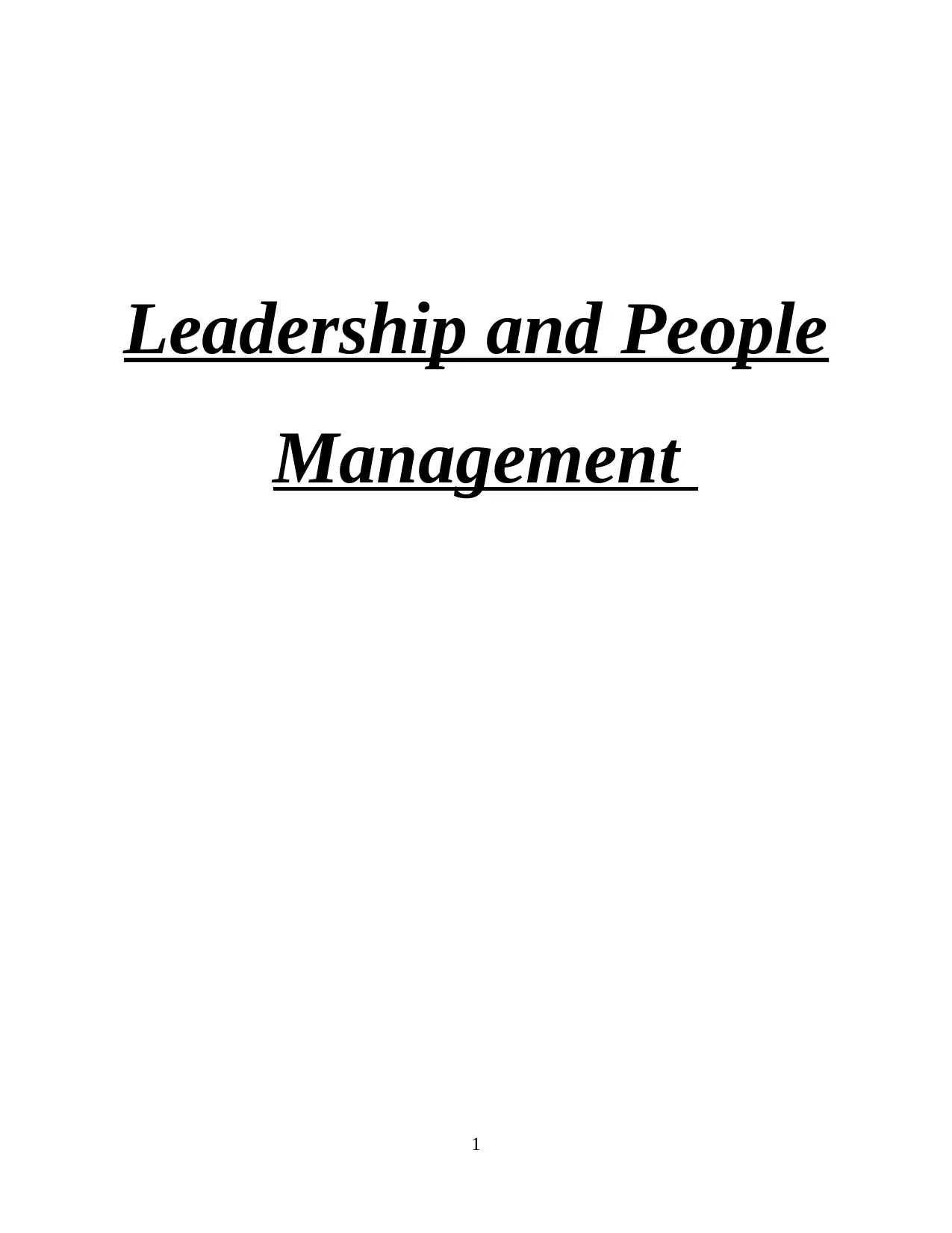
Leadership and People
Management
1
Management
1
Paraphrase This Document
Need a fresh take? Get an instant paraphrase of this document with our AI Paraphraser
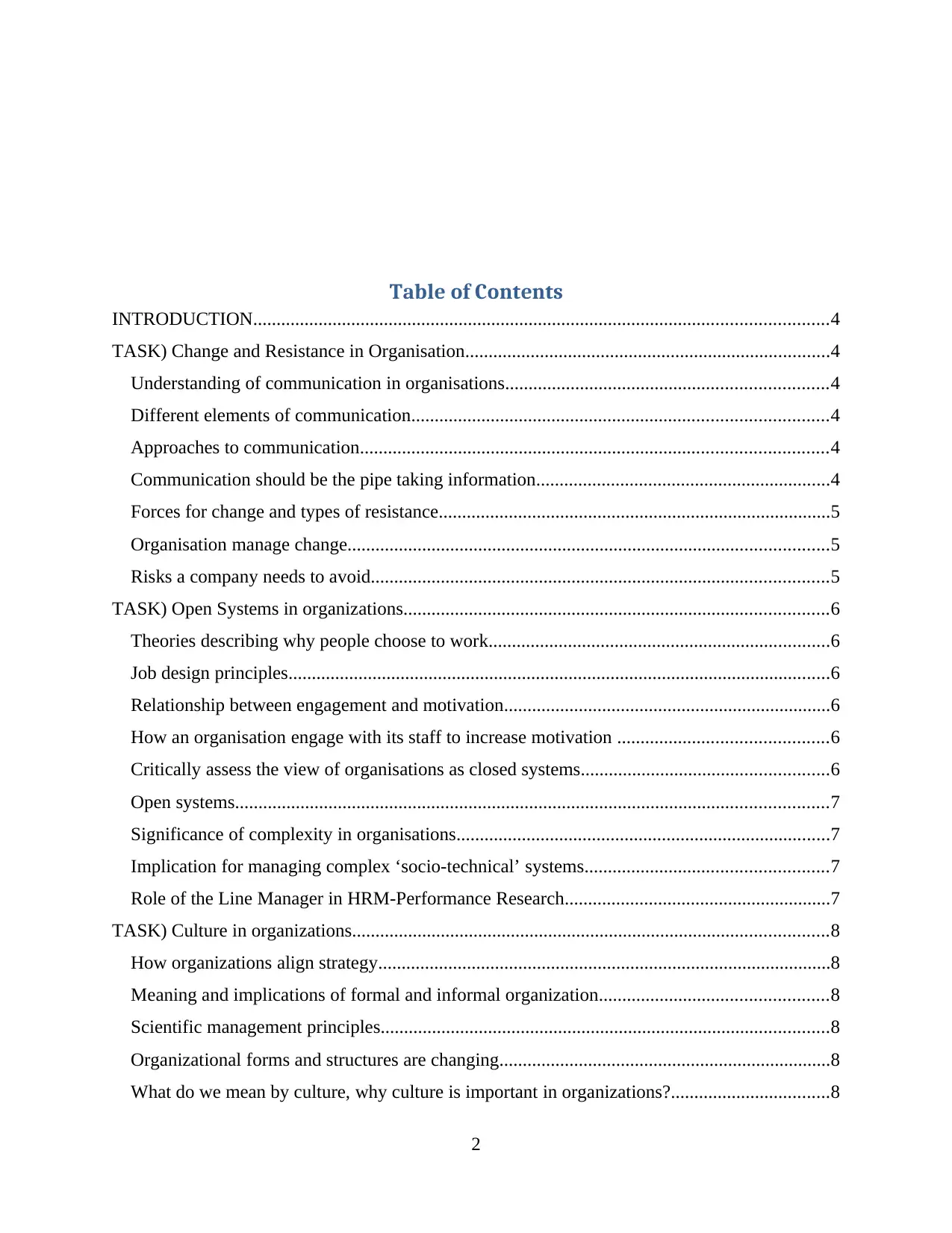
Table of Contents
INTRODUCTION...........................................................................................................................4
TASK) Change and Resistance in Organisation..............................................................................4
Understanding of communication in organisations.....................................................................4
Different elements of communication.........................................................................................4
Approaches to communication....................................................................................................4
Communication should be the pipe taking information...............................................................4
Forces for change and types of resistance....................................................................................5
Organisation manage change.......................................................................................................5
Risks a company needs to avoid..................................................................................................5
TASK) Open Systems in organizations...........................................................................................6
Theories describing why people choose to work.........................................................................6
Job design principles....................................................................................................................6
Relationship between engagement and motivation......................................................................6
How an organisation engage with its staff to increase motivation .............................................6
Critically assess the view of organisations as closed systems.....................................................6
Open systems...............................................................................................................................7
Significance of complexity in organisations................................................................................7
Implication for managing complex ‘socio-technical’ systems....................................................7
Role of the Line Manager in HRM-Performance Research.........................................................7
TASK) Culture in organizations......................................................................................................8
How organizations align strategy.................................................................................................8
Meaning and implications of formal and informal organization.................................................8
Scientific management principles................................................................................................8
Organizational forms and structures are changing.......................................................................8
What do we mean by culture, why culture is important in organizations?..................................8
2
INTRODUCTION...........................................................................................................................4
TASK) Change and Resistance in Organisation..............................................................................4
Understanding of communication in organisations.....................................................................4
Different elements of communication.........................................................................................4
Approaches to communication....................................................................................................4
Communication should be the pipe taking information...............................................................4
Forces for change and types of resistance....................................................................................5
Organisation manage change.......................................................................................................5
Risks a company needs to avoid..................................................................................................5
TASK) Open Systems in organizations...........................................................................................6
Theories describing why people choose to work.........................................................................6
Job design principles....................................................................................................................6
Relationship between engagement and motivation......................................................................6
How an organisation engage with its staff to increase motivation .............................................6
Critically assess the view of organisations as closed systems.....................................................6
Open systems...............................................................................................................................7
Significance of complexity in organisations................................................................................7
Implication for managing complex ‘socio-technical’ systems....................................................7
Role of the Line Manager in HRM-Performance Research.........................................................7
TASK) Culture in organizations......................................................................................................8
How organizations align strategy.................................................................................................8
Meaning and implications of formal and informal organization.................................................8
Scientific management principles................................................................................................8
Organizational forms and structures are changing.......................................................................8
What do we mean by culture, why culture is important in organizations?..................................8
2
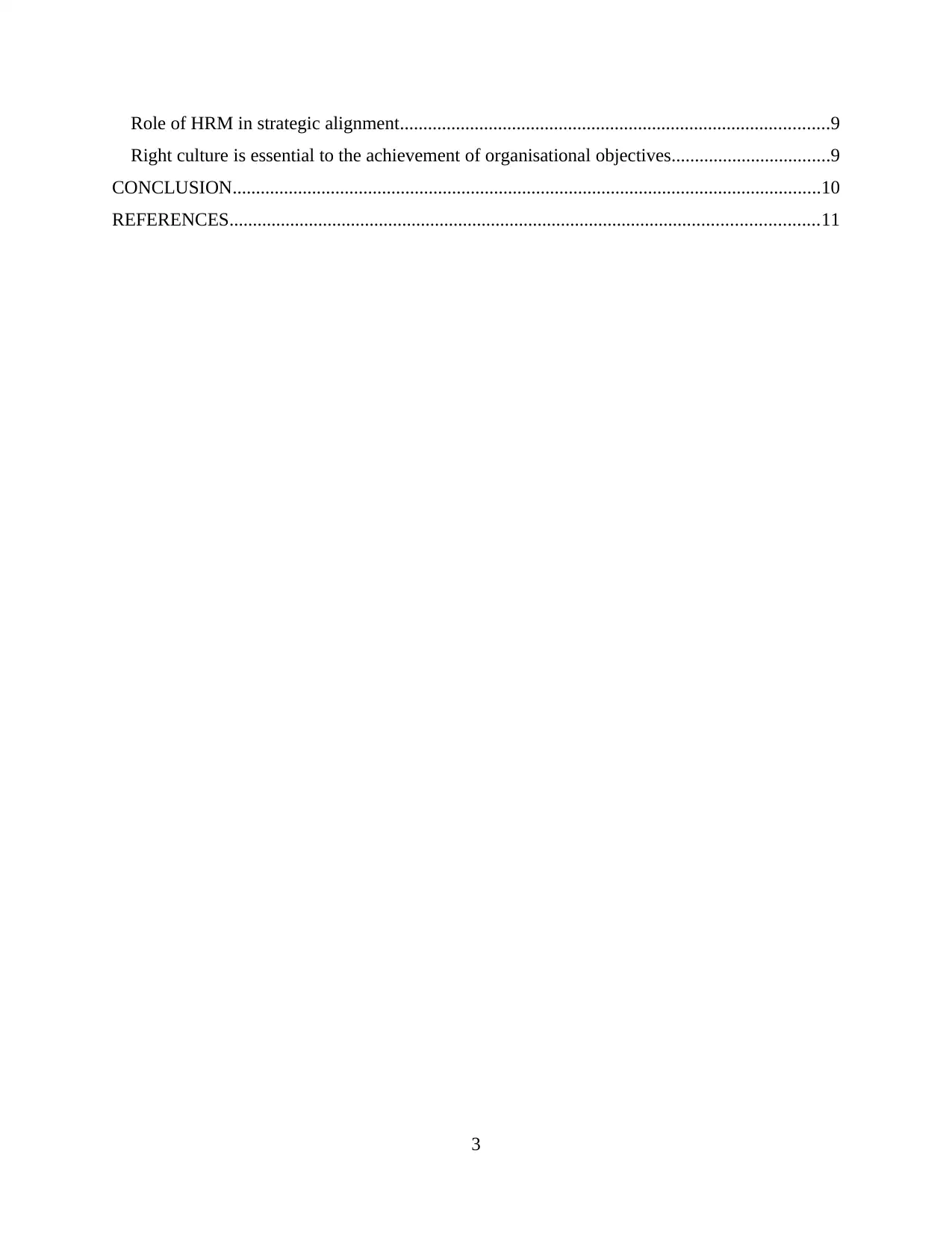
Role of HRM in strategic alignment............................................................................................9
Right culture is essential to the achievement of organisational objectives..................................9
CONCLUSION..............................................................................................................................10
REFERENCES..............................................................................................................................11
3
Right culture is essential to the achievement of organisational objectives..................................9
CONCLUSION..............................................................................................................................10
REFERENCES..............................................................................................................................11
3
⊘ This is a preview!⊘
Do you want full access?
Subscribe today to unlock all pages.

Trusted by 1+ million students worldwide
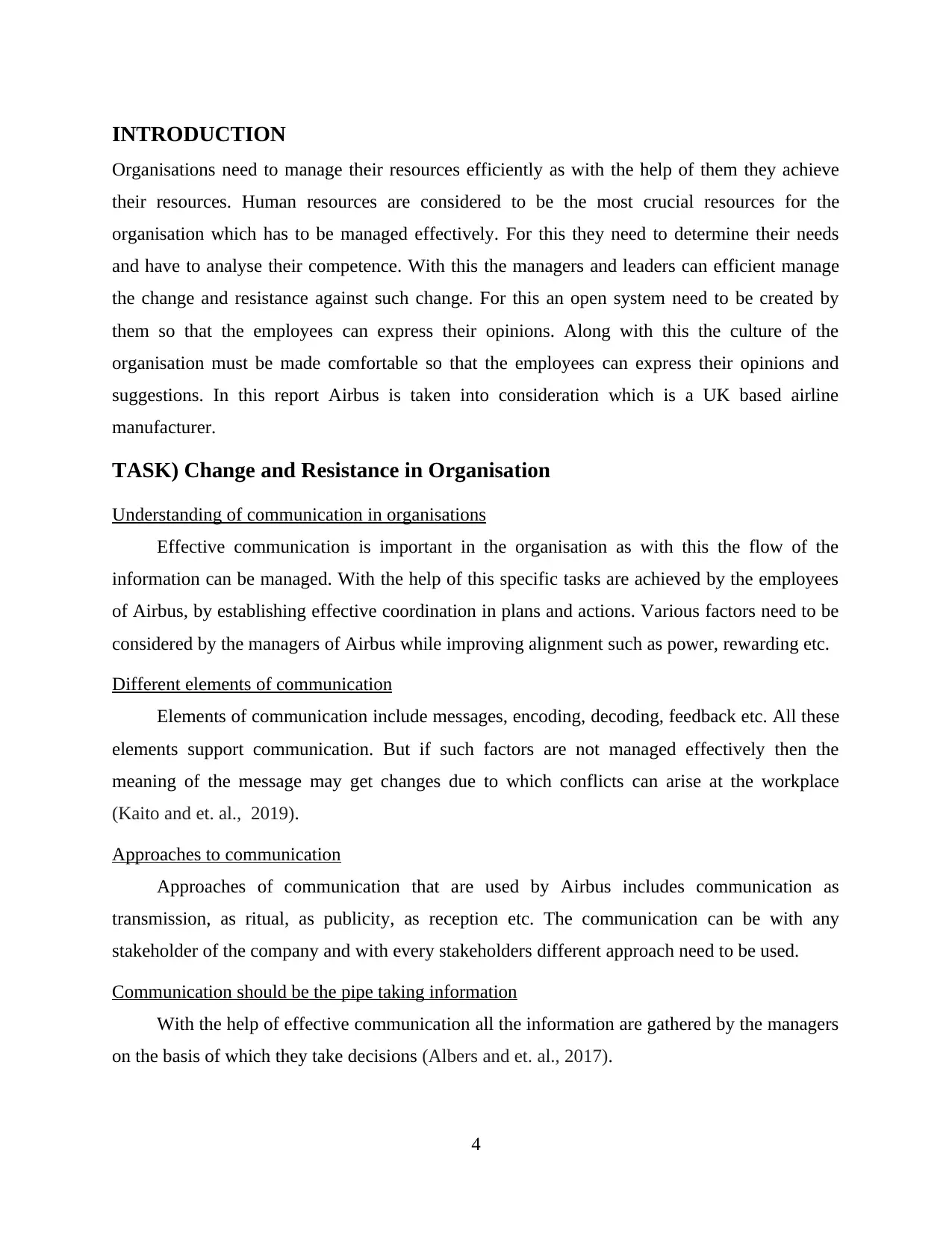
INTRODUCTION
Organisations need to manage their resources efficiently as with the help of them they achieve
their resources. Human resources are considered to be the most crucial resources for the
organisation which has to be managed effectively. For this they need to determine their needs
and have to analyse their competence. With this the managers and leaders can efficient manage
the change and resistance against such change. For this an open system need to be created by
them so that the employees can express their opinions. Along with this the culture of the
organisation must be made comfortable so that the employees can express their opinions and
suggestions. In this report Airbus is taken into consideration which is a UK based airline
manufacturer.
TASK) Change and Resistance in Organisation
Understanding of communication in organisations
Effective communication is important in the organisation as with this the flow of the
information can be managed. With the help of this specific tasks are achieved by the employees
of Airbus, by establishing effective coordination in plans and actions. Various factors need to be
considered by the managers of Airbus while improving alignment such as power, rewarding etc.
Different elements of communication
Elements of communication include messages, encoding, decoding, feedback etc. All these
elements support communication. But if such factors are not managed effectively then the
meaning of the message may get changes due to which conflicts can arise at the workplace
(Kaito and et. al., 2019).
Approaches to communication
Approaches of communication that are used by Airbus includes communication as
transmission, as ritual, as publicity, as reception etc. The communication can be with any
stakeholder of the company and with every stakeholders different approach need to be used.
Communication should be the pipe taking information
With the help of effective communication all the information are gathered by the managers
on the basis of which they take decisions (Albers and et. al., 2017).
4
Organisations need to manage their resources efficiently as with the help of them they achieve
their resources. Human resources are considered to be the most crucial resources for the
organisation which has to be managed effectively. For this they need to determine their needs
and have to analyse their competence. With this the managers and leaders can efficient manage
the change and resistance against such change. For this an open system need to be created by
them so that the employees can express their opinions. Along with this the culture of the
organisation must be made comfortable so that the employees can express their opinions and
suggestions. In this report Airbus is taken into consideration which is a UK based airline
manufacturer.
TASK) Change and Resistance in Organisation
Understanding of communication in organisations
Effective communication is important in the organisation as with this the flow of the
information can be managed. With the help of this specific tasks are achieved by the employees
of Airbus, by establishing effective coordination in plans and actions. Various factors need to be
considered by the managers of Airbus while improving alignment such as power, rewarding etc.
Different elements of communication
Elements of communication include messages, encoding, decoding, feedback etc. All these
elements support communication. But if such factors are not managed effectively then the
meaning of the message may get changes due to which conflicts can arise at the workplace
(Kaito and et. al., 2019).
Approaches to communication
Approaches of communication that are used by Airbus includes communication as
transmission, as ritual, as publicity, as reception etc. The communication can be with any
stakeholder of the company and with every stakeholders different approach need to be used.
Communication should be the pipe taking information
With the help of effective communication all the information are gathered by the managers
on the basis of which they take decisions (Albers and et. al., 2017).
4
Paraphrase This Document
Need a fresh take? Get an instant paraphrase of this document with our AI Paraphraser
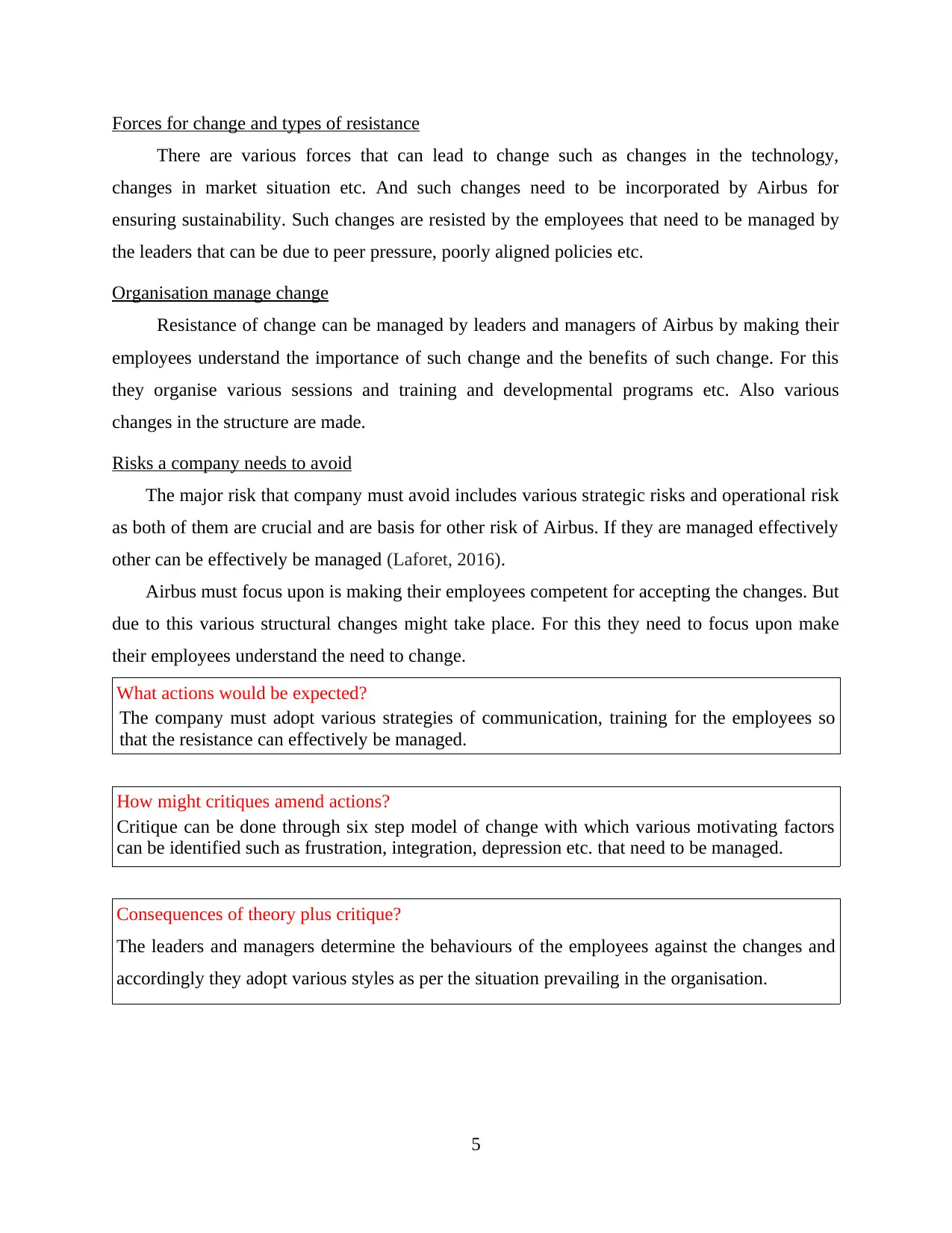
Forces for change and types of resistance
There are various forces that can lead to change such as changes in the technology,
changes in market situation etc. And such changes need to be incorporated by Airbus for
ensuring sustainability. Such changes are resisted by the employees that need to be managed by
the leaders that can be due to peer pressure, poorly aligned policies etc.
Organisation manage change
Resistance of change can be managed by leaders and managers of Airbus by making their
employees understand the importance of such change and the benefits of such change. For this
they organise various sessions and training and developmental programs etc. Also various
changes in the structure are made.
Risks a company needs to avoid
The major risk that company must avoid includes various strategic risks and operational risk
as both of them are crucial and are basis for other risk of Airbus. If they are managed effectively
other can be effectively be managed (Laforet, 2016).
Airbus must focus upon is making their employees competent for accepting the changes. But
due to this various structural changes might take place. For this they need to focus upon make
their employees understand the need to change.
What actions would be expected?
The company must adopt various strategies of communication, training for the employees so
that the resistance can effectively be managed.
How might critiques amend actions?
Critique can be done through six step model of change with which various motivating factors
can be identified such as frustration, integration, depression etc. that need to be managed.
Consequences of theory plus critique?
The leaders and managers determine the behaviours of the employees against the changes and
accordingly they adopt various styles as per the situation prevailing in the organisation.
5
There are various forces that can lead to change such as changes in the technology,
changes in market situation etc. And such changes need to be incorporated by Airbus for
ensuring sustainability. Such changes are resisted by the employees that need to be managed by
the leaders that can be due to peer pressure, poorly aligned policies etc.
Organisation manage change
Resistance of change can be managed by leaders and managers of Airbus by making their
employees understand the importance of such change and the benefits of such change. For this
they organise various sessions and training and developmental programs etc. Also various
changes in the structure are made.
Risks a company needs to avoid
The major risk that company must avoid includes various strategic risks and operational risk
as both of them are crucial and are basis for other risk of Airbus. If they are managed effectively
other can be effectively be managed (Laforet, 2016).
Airbus must focus upon is making their employees competent for accepting the changes. But
due to this various structural changes might take place. For this they need to focus upon make
their employees understand the need to change.
What actions would be expected?
The company must adopt various strategies of communication, training for the employees so
that the resistance can effectively be managed.
How might critiques amend actions?
Critique can be done through six step model of change with which various motivating factors
can be identified such as frustration, integration, depression etc. that need to be managed.
Consequences of theory plus critique?
The leaders and managers determine the behaviours of the employees against the changes and
accordingly they adopt various styles as per the situation prevailing in the organisation.
5
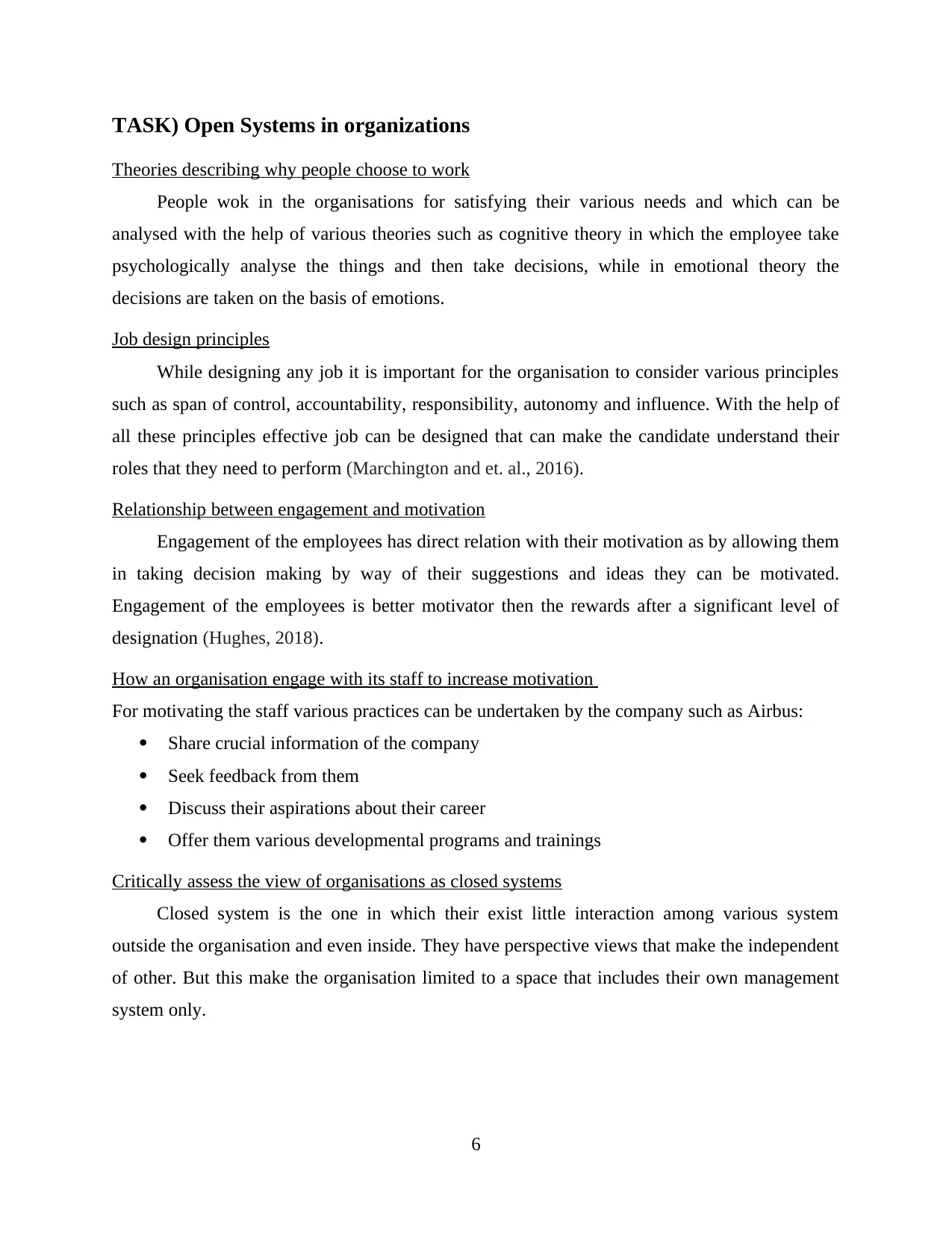
TASK) Open Systems in organizations
Theories describing why people choose to work
People wok in the organisations for satisfying their various needs and which can be
analysed with the help of various theories such as cognitive theory in which the employee take
psychologically analyse the things and then take decisions, while in emotional theory the
decisions are taken on the basis of emotions.
Job design principles
While designing any job it is important for the organisation to consider various principles
such as span of control, accountability, responsibility, autonomy and influence. With the help of
all these principles effective job can be designed that can make the candidate understand their
roles that they need to perform (Marchington and et. al., 2016).
Relationship between engagement and motivation
Engagement of the employees has direct relation with their motivation as by allowing them
in taking decision making by way of their suggestions and ideas they can be motivated.
Engagement of the employees is better motivator then the rewards after a significant level of
designation (Hughes, 2018).
How an organisation engage with its staff to increase motivation
For motivating the staff various practices can be undertaken by the company such as Airbus:
Share crucial information of the company
Seek feedback from them
Discuss their aspirations about their career
Offer them various developmental programs and trainings
Critically assess the view of organisations as closed systems
Closed system is the one in which their exist little interaction among various system
outside the organisation and even inside. They have perspective views that make the independent
of other. But this make the organisation limited to a space that includes their own management
system only.
6
Theories describing why people choose to work
People wok in the organisations for satisfying their various needs and which can be
analysed with the help of various theories such as cognitive theory in which the employee take
psychologically analyse the things and then take decisions, while in emotional theory the
decisions are taken on the basis of emotions.
Job design principles
While designing any job it is important for the organisation to consider various principles
such as span of control, accountability, responsibility, autonomy and influence. With the help of
all these principles effective job can be designed that can make the candidate understand their
roles that they need to perform (Marchington and et. al., 2016).
Relationship between engagement and motivation
Engagement of the employees has direct relation with their motivation as by allowing them
in taking decision making by way of their suggestions and ideas they can be motivated.
Engagement of the employees is better motivator then the rewards after a significant level of
designation (Hughes, 2018).
How an organisation engage with its staff to increase motivation
For motivating the staff various practices can be undertaken by the company such as Airbus:
Share crucial information of the company
Seek feedback from them
Discuss their aspirations about their career
Offer them various developmental programs and trainings
Critically assess the view of organisations as closed systems
Closed system is the one in which their exist little interaction among various system
outside the organisation and even inside. They have perspective views that make the independent
of other. But this make the organisation limited to a space that includes their own management
system only.
6
⊘ This is a preview!⊘
Do you want full access?
Subscribe today to unlock all pages.

Trusted by 1+ million students worldwide
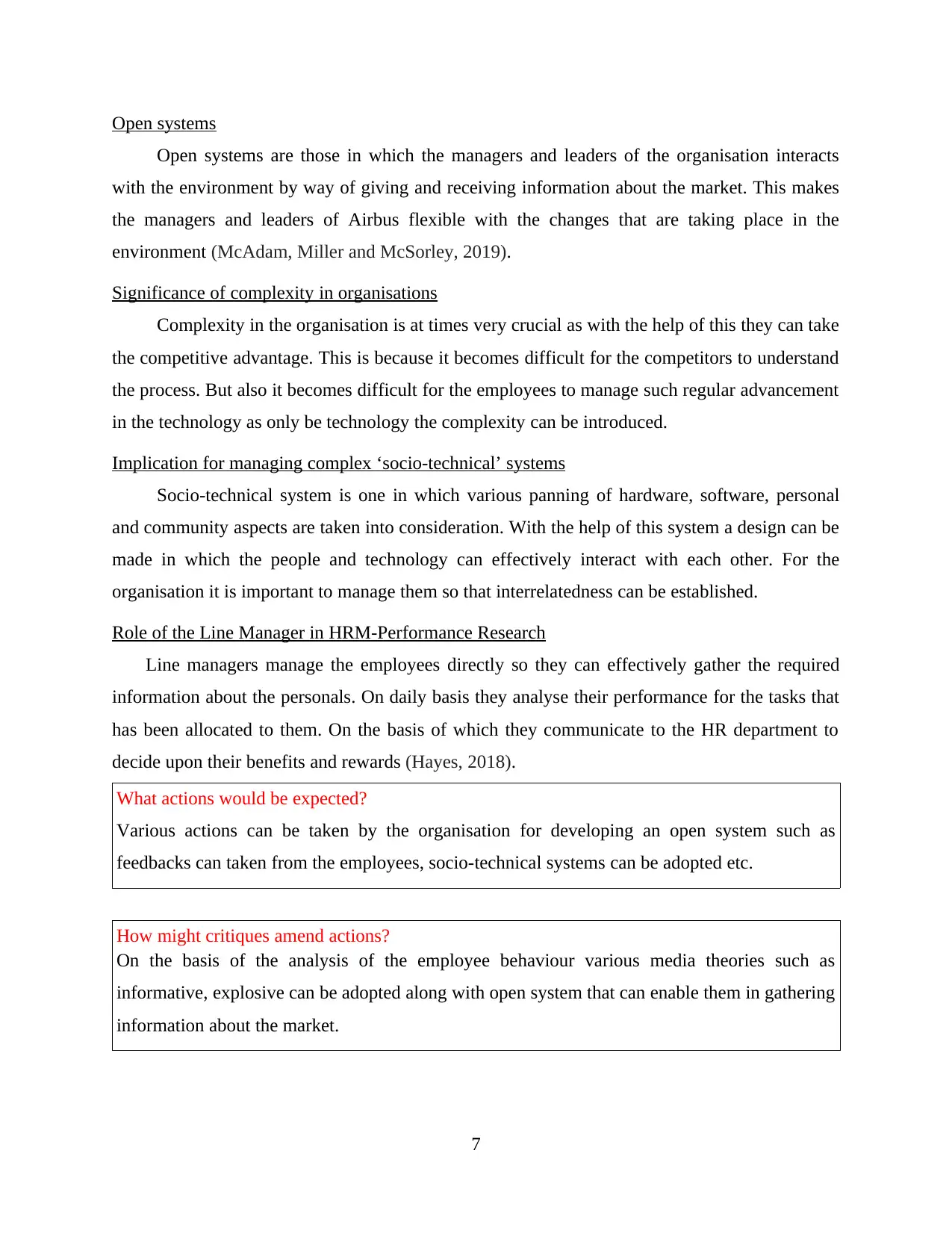
Open systems
Open systems are those in which the managers and leaders of the organisation interacts
with the environment by way of giving and receiving information about the market. This makes
the managers and leaders of Airbus flexible with the changes that are taking place in the
environment (McAdam, Miller and McSorley, 2019).
Significance of complexity in organisations
Complexity in the organisation is at times very crucial as with the help of this they can take
the competitive advantage. This is because it becomes difficult for the competitors to understand
the process. But also it becomes difficult for the employees to manage such regular advancement
in the technology as only be technology the complexity can be introduced.
Implication for managing complex ‘socio-technical’ systems
Socio-technical system is one in which various panning of hardware, software, personal
and community aspects are taken into consideration. With the help of this system a design can be
made in which the people and technology can effectively interact with each other. For the
organisation it is important to manage them so that interrelatedness can be established.
Role of the Line Manager in HRM-Performance Research
Line managers manage the employees directly so they can effectively gather the required
information about the personals. On daily basis they analyse their performance for the tasks that
has been allocated to them. On the basis of which they communicate to the HR department to
decide upon their benefits and rewards (Hayes, 2018).
What actions would be expected?
Various actions can be taken by the organisation for developing an open system such as
feedbacks can taken from the employees, socio-technical systems can be adopted etc.
How might critiques amend actions?
On the basis of the analysis of the employee behaviour various media theories such as
informative, explosive can be adopted along with open system that can enable them in gathering
information about the market.
7
Open systems are those in which the managers and leaders of the organisation interacts
with the environment by way of giving and receiving information about the market. This makes
the managers and leaders of Airbus flexible with the changes that are taking place in the
environment (McAdam, Miller and McSorley, 2019).
Significance of complexity in organisations
Complexity in the organisation is at times very crucial as with the help of this they can take
the competitive advantage. This is because it becomes difficult for the competitors to understand
the process. But also it becomes difficult for the employees to manage such regular advancement
in the technology as only be technology the complexity can be introduced.
Implication for managing complex ‘socio-technical’ systems
Socio-technical system is one in which various panning of hardware, software, personal
and community aspects are taken into consideration. With the help of this system a design can be
made in which the people and technology can effectively interact with each other. For the
organisation it is important to manage them so that interrelatedness can be established.
Role of the Line Manager in HRM-Performance Research
Line managers manage the employees directly so they can effectively gather the required
information about the personals. On daily basis they analyse their performance for the tasks that
has been allocated to them. On the basis of which they communicate to the HR department to
decide upon their benefits and rewards (Hayes, 2018).
What actions would be expected?
Various actions can be taken by the organisation for developing an open system such as
feedbacks can taken from the employees, socio-technical systems can be adopted etc.
How might critiques amend actions?
On the basis of the analysis of the employee behaviour various media theories such as
informative, explosive can be adopted along with open system that can enable them in gathering
information about the market.
7
Paraphrase This Document
Need a fresh take? Get an instant paraphrase of this document with our AI Paraphraser
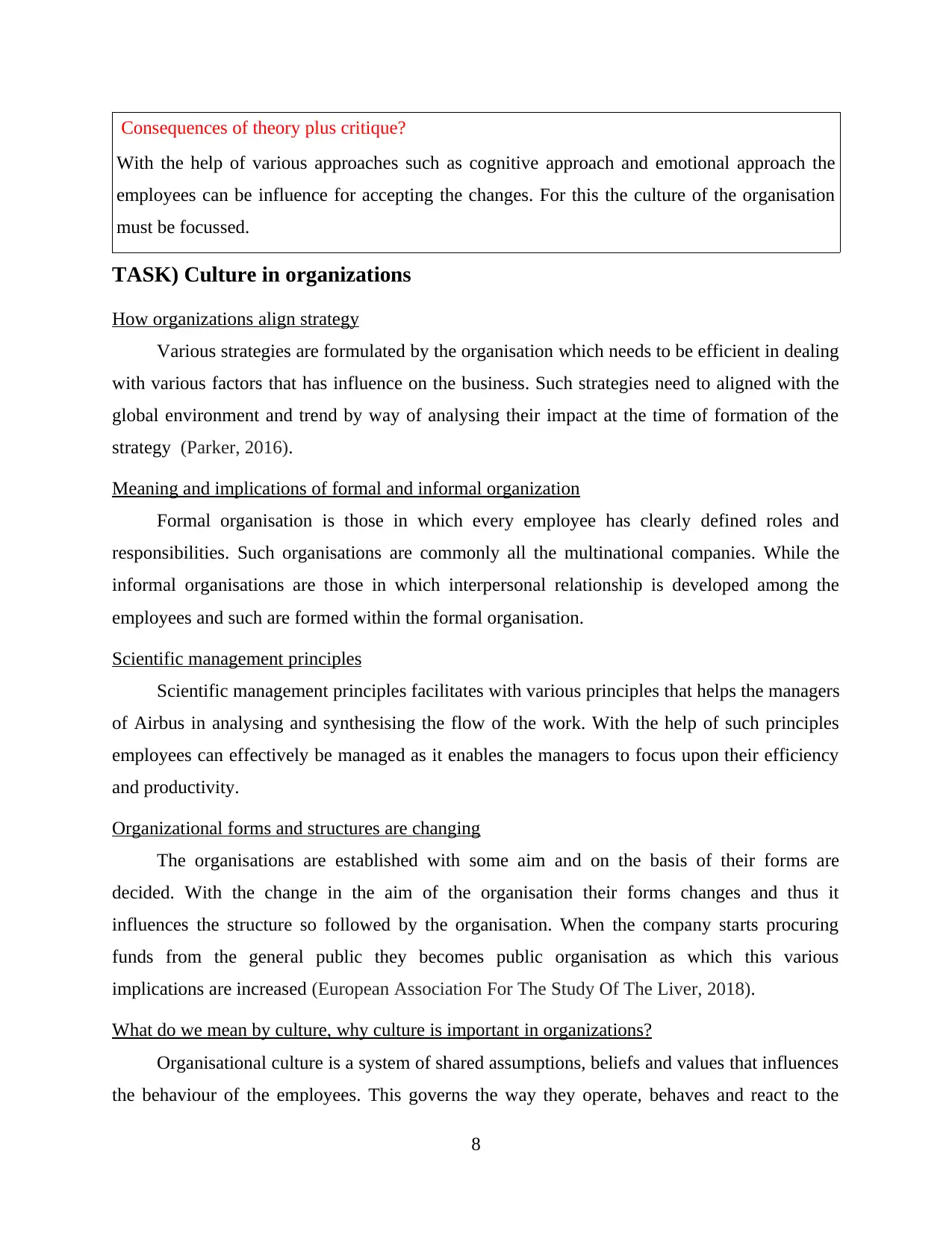
Consequences of theory plus critique?
With the help of various approaches such as cognitive approach and emotional approach the
employees can be influence for accepting the changes. For this the culture of the organisation
must be focussed.
TASK) Culture in organizations
How organizations align strategy
Various strategies are formulated by the organisation which needs to be efficient in dealing
with various factors that has influence on the business. Such strategies need to aligned with the
global environment and trend by way of analysing their impact at the time of formation of the
strategy (Parker, 2016).
Meaning and implications of formal and informal organization
Formal organisation is those in which every employee has clearly defined roles and
responsibilities. Such organisations are commonly all the multinational companies. While the
informal organisations are those in which interpersonal relationship is developed among the
employees and such are formed within the formal organisation.
Scientific management principles
Scientific management principles facilitates with various principles that helps the managers
of Airbus in analysing and synthesising the flow of the work. With the help of such principles
employees can effectively be managed as it enables the managers to focus upon their efficiency
and productivity.
Organizational forms and structures are changing
The organisations are established with some aim and on the basis of their forms are
decided. With the change in the aim of the organisation their forms changes and thus it
influences the structure so followed by the organisation. When the company starts procuring
funds from the general public they becomes public organisation as which this various
implications are increased (European Association For The Study Of The Liver, 2018).
What do we mean by culture, why culture is important in organizations?
Organisational culture is a system of shared assumptions, beliefs and values that influences
the behaviour of the employees. This governs the way they operate, behaves and react to the
8
With the help of various approaches such as cognitive approach and emotional approach the
employees can be influence for accepting the changes. For this the culture of the organisation
must be focussed.
TASK) Culture in organizations
How organizations align strategy
Various strategies are formulated by the organisation which needs to be efficient in dealing
with various factors that has influence on the business. Such strategies need to aligned with the
global environment and trend by way of analysing their impact at the time of formation of the
strategy (Parker, 2016).
Meaning and implications of formal and informal organization
Formal organisation is those in which every employee has clearly defined roles and
responsibilities. Such organisations are commonly all the multinational companies. While the
informal organisations are those in which interpersonal relationship is developed among the
employees and such are formed within the formal organisation.
Scientific management principles
Scientific management principles facilitates with various principles that helps the managers
of Airbus in analysing and synthesising the flow of the work. With the help of such principles
employees can effectively be managed as it enables the managers to focus upon their efficiency
and productivity.
Organizational forms and structures are changing
The organisations are established with some aim and on the basis of their forms are
decided. With the change in the aim of the organisation their forms changes and thus it
influences the structure so followed by the organisation. When the company starts procuring
funds from the general public they becomes public organisation as which this various
implications are increased (European Association For The Study Of The Liver, 2018).
What do we mean by culture, why culture is important in organizations?
Organisational culture is a system of shared assumptions, beliefs and values that influences
the behaviour of the employees. This governs the way they operate, behaves and react to the
8
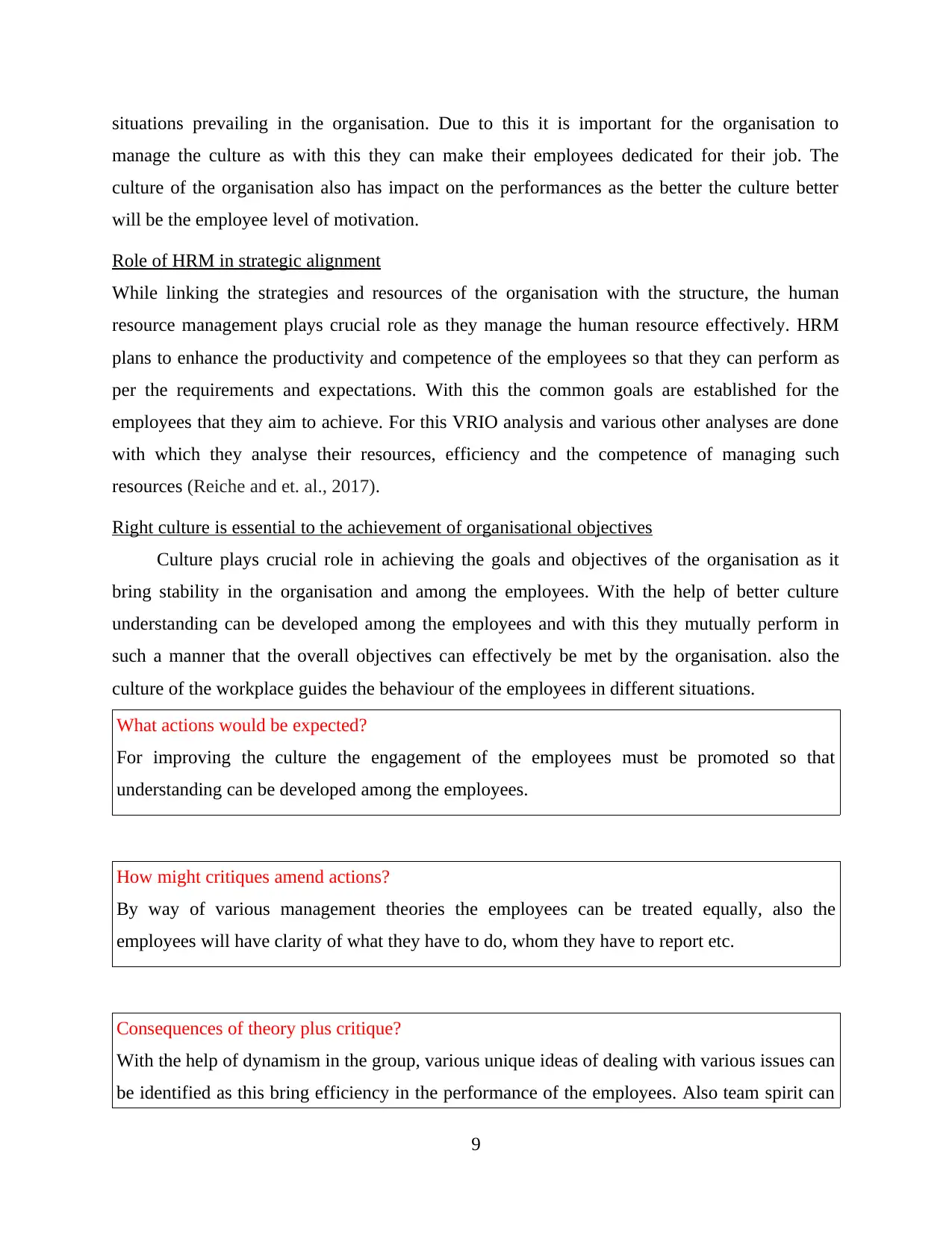
situations prevailing in the organisation. Due to this it is important for the organisation to
manage the culture as with this they can make their employees dedicated for their job. The
culture of the organisation also has impact on the performances as the better the culture better
will be the employee level of motivation.
Role of HRM in strategic alignment
While linking the strategies and resources of the organisation with the structure, the human
resource management plays crucial role as they manage the human resource effectively. HRM
plans to enhance the productivity and competence of the employees so that they can perform as
per the requirements and expectations. With this the common goals are established for the
employees that they aim to achieve. For this VRIO analysis and various other analyses are done
with which they analyse their resources, efficiency and the competence of managing such
resources (Reiche and et. al., 2017).
Right culture is essential to the achievement of organisational objectives
Culture plays crucial role in achieving the goals and objectives of the organisation as it
bring stability in the organisation and among the employees. With the help of better culture
understanding can be developed among the employees and with this they mutually perform in
such a manner that the overall objectives can effectively be met by the organisation. also the
culture of the workplace guides the behaviour of the employees in different situations.
What actions would be expected?
For improving the culture the engagement of the employees must be promoted so that
understanding can be developed among the employees.
How might critiques amend actions?
By way of various management theories the employees can be treated equally, also the
employees will have clarity of what they have to do, whom they have to report etc.
Consequences of theory plus critique?
With the help of dynamism in the group, various unique ideas of dealing with various issues can
be identified as this bring efficiency in the performance of the employees. Also team spirit can
9
manage the culture as with this they can make their employees dedicated for their job. The
culture of the organisation also has impact on the performances as the better the culture better
will be the employee level of motivation.
Role of HRM in strategic alignment
While linking the strategies and resources of the organisation with the structure, the human
resource management plays crucial role as they manage the human resource effectively. HRM
plans to enhance the productivity and competence of the employees so that they can perform as
per the requirements and expectations. With this the common goals are established for the
employees that they aim to achieve. For this VRIO analysis and various other analyses are done
with which they analyse their resources, efficiency and the competence of managing such
resources (Reiche and et. al., 2017).
Right culture is essential to the achievement of organisational objectives
Culture plays crucial role in achieving the goals and objectives of the organisation as it
bring stability in the organisation and among the employees. With the help of better culture
understanding can be developed among the employees and with this they mutually perform in
such a manner that the overall objectives can effectively be met by the organisation. also the
culture of the workplace guides the behaviour of the employees in different situations.
What actions would be expected?
For improving the culture the engagement of the employees must be promoted so that
understanding can be developed among the employees.
How might critiques amend actions?
By way of various management theories the employees can be treated equally, also the
employees will have clarity of what they have to do, whom they have to report etc.
Consequences of theory plus critique?
With the help of dynamism in the group, various unique ideas of dealing with various issues can
be identified as this bring efficiency in the performance of the employees. Also team spirit can
9
⊘ This is a preview!⊘
Do you want full access?
Subscribe today to unlock all pages.

Trusted by 1+ million students worldwide
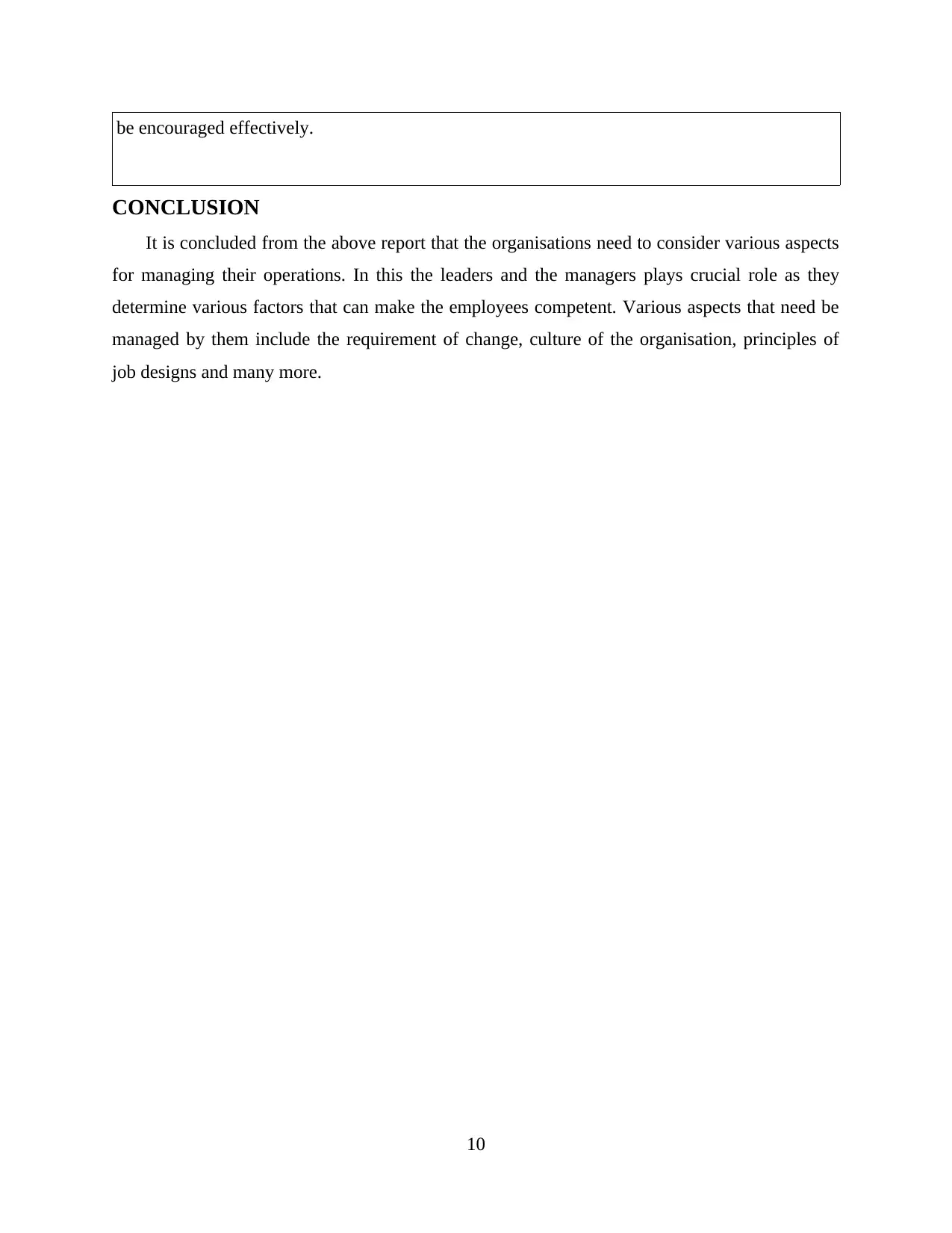
be encouraged effectively.
CONCLUSION
It is concluded from the above report that the organisations need to consider various aspects
for managing their operations. In this the leaders and the managers plays crucial role as they
determine various factors that can make the employees competent. Various aspects that need be
managed by them include the requirement of change, culture of the organisation, principles of
job designs and many more.
10
CONCLUSION
It is concluded from the above report that the organisations need to consider various aspects
for managing their operations. In this the leaders and the managers plays crucial role as they
determine various factors that can make the employees competent. Various aspects that need be
managed by them include the requirement of change, culture of the organisation, principles of
job designs and many more.
10
Paraphrase This Document
Need a fresh take? Get an instant paraphrase of this document with our AI Paraphraser
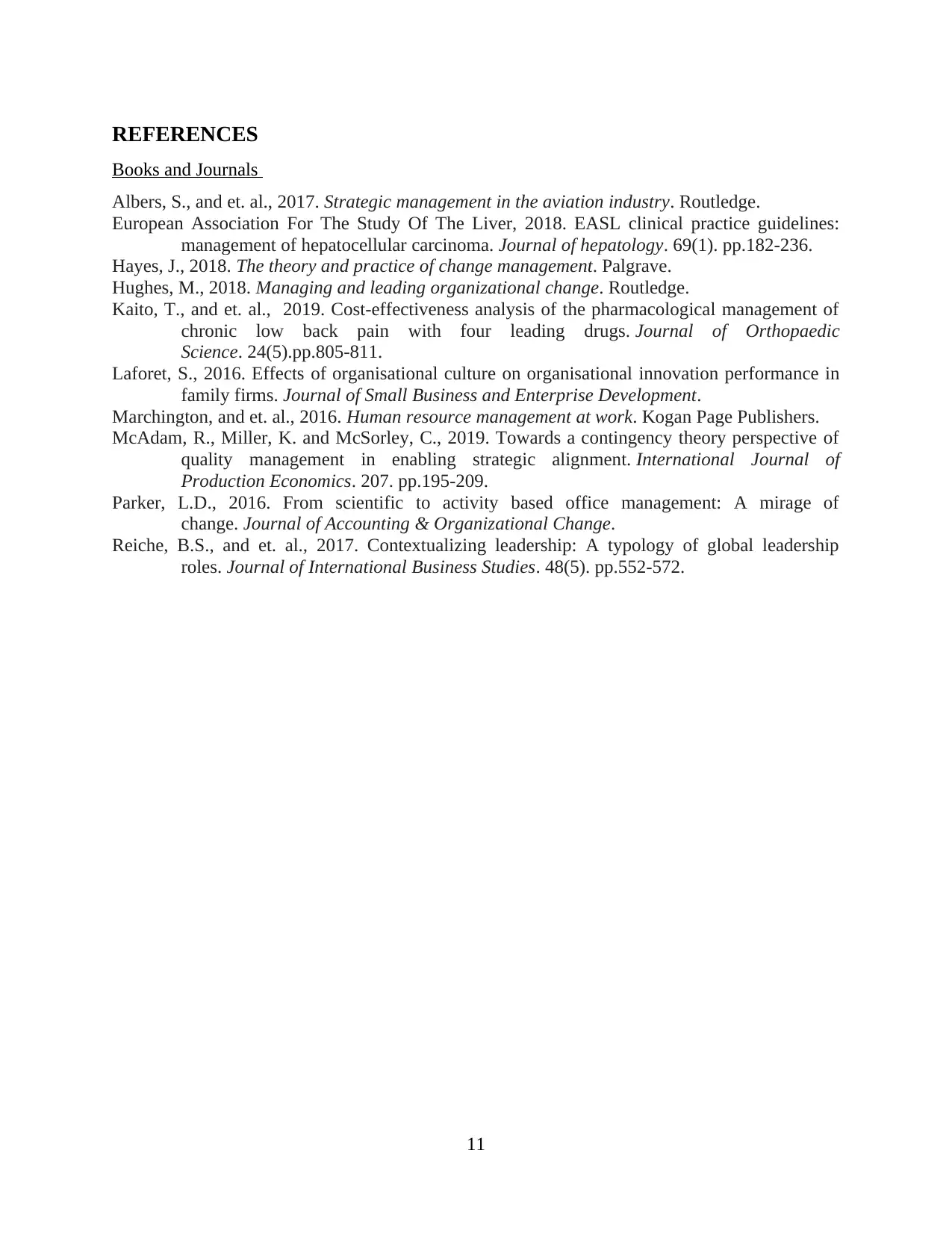
REFERENCES
Books and Journals
Albers, S., and et. al., 2017. Strategic management in the aviation industry. Routledge.
European Association For The Study Of The Liver, 2018. EASL clinical practice guidelines:
management of hepatocellular carcinoma. Journal of hepatology. 69(1). pp.182-236.
Hayes, J., 2018. The theory and practice of change management. Palgrave.
Hughes, M., 2018. Managing and leading organizational change. Routledge.
Kaito, T., and et. al., 2019. Cost-effectiveness analysis of the pharmacological management of
chronic low back pain with four leading drugs. Journal of Orthopaedic
Science. 24(5).pp.805-811.
Laforet, S., 2016. Effects of organisational culture on organisational innovation performance in
family firms. Journal of Small Business and Enterprise Development.
Marchington, and et. al., 2016. Human resource management at work. Kogan Page Publishers.
McAdam, R., Miller, K. and McSorley, C., 2019. Towards a contingency theory perspective of
quality management in enabling strategic alignment. International Journal of
Production Economics. 207. pp.195-209.
Parker, L.D., 2016. From scientific to activity based office management: A mirage of
change. Journal of Accounting & Organizational Change.
Reiche, B.S., and et. al., 2017. Contextualizing leadership: A typology of global leadership
roles. Journal of International Business Studies. 48(5). pp.552-572.
11
Books and Journals
Albers, S., and et. al., 2017. Strategic management in the aviation industry. Routledge.
European Association For The Study Of The Liver, 2018. EASL clinical practice guidelines:
management of hepatocellular carcinoma. Journal of hepatology. 69(1). pp.182-236.
Hayes, J., 2018. The theory and practice of change management. Palgrave.
Hughes, M., 2018. Managing and leading organizational change. Routledge.
Kaito, T., and et. al., 2019. Cost-effectiveness analysis of the pharmacological management of
chronic low back pain with four leading drugs. Journal of Orthopaedic
Science. 24(5).pp.805-811.
Laforet, S., 2016. Effects of organisational culture on organisational innovation performance in
family firms. Journal of Small Business and Enterprise Development.
Marchington, and et. al., 2016. Human resource management at work. Kogan Page Publishers.
McAdam, R., Miller, K. and McSorley, C., 2019. Towards a contingency theory perspective of
quality management in enabling strategic alignment. International Journal of
Production Economics. 207. pp.195-209.
Parker, L.D., 2016. From scientific to activity based office management: A mirage of
change. Journal of Accounting & Organizational Change.
Reiche, B.S., and et. al., 2017. Contextualizing leadership: A typology of global leadership
roles. Journal of International Business Studies. 48(5). pp.552-572.
11
1 out of 11
Related Documents
Your All-in-One AI-Powered Toolkit for Academic Success.
+13062052269
info@desklib.com
Available 24*7 on WhatsApp / Email
![[object Object]](/_next/static/media/star-bottom.7253800d.svg)
Unlock your academic potential
Copyright © 2020–2025 A2Z Services. All Rights Reserved. Developed and managed by ZUCOL.



